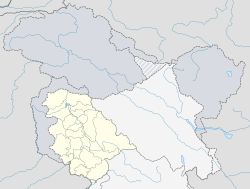Tral
Tral | |
|---|---|
Town | |
 Tral Location in Jammu and Kashmir, India | |
| Coordinates: 33°56′N 75°06′E / 33.93°N 75.1°ECoordinates: 33°56′N 75°06′E / 33.93°N 75.1°E | |
| Country | |
| Union territory | Jammu and Kashmir |
| District | Pulwama |
| Elevation | 1,662 m (5,453 ft) |
| Population (2011) | |
| • Total | 17,845 |
| Languages | |
| • Official | Kashmiri, Urdu, Hindi, Dogri, English[1][2] |
| • Spoken | Gujari |
| Time zone | UTC+5:30 (IST) |
| PIN | 192123 |
| Telephone code | 01933 |
| Literacy | 98.1% |
| Website | www |
Tral is a town, sub-district and a notified area committee in Pulwama district of Jammu and Kashmir which is situated at a distance of 11 km (6.8 mi) from Awantipora. Tral is situated around 40 km (25 mi) from summer capital Srinagar and 20 km (12 mi) from district headquarters Pulwama. Tral is the largest area committee in Pulwama district after Pulwama followed by Awantipora and Pampore sub-districts.
History[]
Gufkral represents an important site in the area, near the town of Tral.[3] Gufkral is located at Banmir village in Hurdumir area of Tral, five km (3.1 mi) from the sub district headquarter. The village falls between two nallahs (streams) on an extensive deposit of Karewa (elevated table-land) where people used to live in ancient times.
Geography[]
Tral is located at 33°56′N 75°06′E / 33.93°N 75.1°E.[4] It has an average elevation of 1,662 metres (5,453 ft) and its average area is 110 km2 (42 sq mi).
Demographics[]
As of 2011 India census,[5] Tral had a population of 17,844 with 9,944 males constituting 55.7% of the population and 7,900 females constituting 44.3% of the population.
Religion[]
According to the 2011 census, Islam is practised by about 88.84% of the population, while 10.18% follow Hinduism and 0.60% follow Sikhism.
Security situation[]
Tral is a volatile area in Jammu & Kashmir and a hotbed of militancy. Burhan Muzaffar Wani, former commander of Hizbul Mujahideen, hailed from Tral.[7] Hizbul Mujahideen commander Sabzar Bhat, successor of Burhan Wani hailing from Ratsuna Tral was also killed in Soimoh Tral, by Indian security forces sparking days of unrest.[8] Ansar Ghazwat-ul-Hind (Kashmir based Al Qaeda Cell) is also believed to be operated from Tral as its founder and chief Zakir Musa hailed from Noorpora village of Tral Town.
Tral Wildlife Sanctuary[]
On 26 October 2019, the government declared a new breeding ground for endangered Kashmiri stag (Hangul) in Tral area. It was named as Tral Wildlife Sanctuary which is spread over 154.15 km2 (59.52 sq mi) and came into being by merging Paner-Shikargah forest area in Tral with Overa Aru Wildlife Sanctuary in Pahalgam.
Villages in Tral Tehsil[]
1. Ali Gund 2. Amirabad 3. Amlar 4. Arigam Ullar 5. Aripal 6. Baragam 7. Batagund 8. Brental 9. Bathnoor Jagir 10. Begh Gund 11. Boochu 12. Chandrigam 13. Chatrugam 14. Chewa Ullar 15. Cheribugh 16. Dadasara 17. Dar Ganie Gund 18. Deedarpora 19. Dewar 20. Dharamgund 21. Doonigund 22. Gameraj 23. Gutroo 24. Gulab Bagh 25. Gulistan 26. Gulshanpora 27. Gwaang 28. Hajinar 29. Hurdumir 30. Heewan 31. Jawahirpora 32. Khanagund 33. Khasipora 34. Kuchmulla 35. Kaarmulla 36. Lalgam 37. Lalpora 38. Laribal 39. Lariyar 40. Lurgam 41. Lurow Jagir 42. Machhama 43. Mandoora 44. Monghama 45. Nader 46. Nigeenpora 47. Naibugh 48. Nanner Midoora 49. Nawdal 50. Nazneenpora 51. Nargistan 52. Panner Jagir 53. Panzoo 54. Pethgam Gadpora 55. Pinglish 56. Pranigam 57. Quil Shikargah 58. Rathsuna 59. Sangrama 60. Seer Jagir 61. Shahpora 62. Sheerabad 63. Saimoh 64. Satoora 65. Takiya Gulab Bagh 66. Wagad.
Divisions[]
The main town area of Tral is divided into two parts/divisions namely Upper Tral (Tral i Bala) and Lower Tral (Tral Payeen or Tral i Payeen). There is a significant difference in the altitudes of these two divisions/parts as their name suggests itself. The population of Lower Tral (Tral Payeen) is more than that of Upper Tral (Tral i Bala).
Notable people[]
- Moulana Noor Ahmad Trali- Religious Scholar.
- Rajab Hamid- Poet.
- Ali Muhammad Naik- Former NC Leader.
Tourist Attractions[]
Nagberan (Upper Dachigam), Aripal village/spring, Dilnag and Shikargah are the main tourist attractions of Tral. Tarsar-Marsar lakes are also accessible via the meadows of Nagberan.
Education[]
Tral has a very high literacy rate of about 98.1% which is quite higher than the average national literacy rate. There are various educational institutions in and around Tral town which provide education to the local populace of students. Tral area has also produced a number of educationists and intellectuals in the past.
References[]
- ^ "The Jammu and Kashmir Official Languages Act, 2020" (PDF). The Gazette of India. 27 September 2020. Retrieved 27 September 2020.
- ^ "Parliament passes JK Official Languages Bill, 2020". Rising Kashmir. 23 September 2020. Retrieved 30 May 2021.
- ^ "Extending Kashmiriyat to Embrace Burzahom".
- ^ "Maps, Weather, and Airports for Tral, India". fallingrain.com.
- ^ "Census of India". www.censusindia.gov.in. Ministry of Home Affairs, Government of India. Retrieved 27 July 2014.
- ^ "Tral Town Population". Census India. Retrieved 10 July 2021.
- ^ "Why south Kashmir is becoming the new hotbed of militancy". dailyo.in.
- ^ "Top rebel commander Sabzar Ahmad Bhat killed in Kashmir". Al Jazeera. May 2017.
Sabzar Ahmad Bhat, a senior leader of the Hizbul Mujahideen group, was killed overnight by government troops in Tral area, some 40km south of Kashmir's capital, Srinagar, police said.
- Cities and towns in Pulwama district


